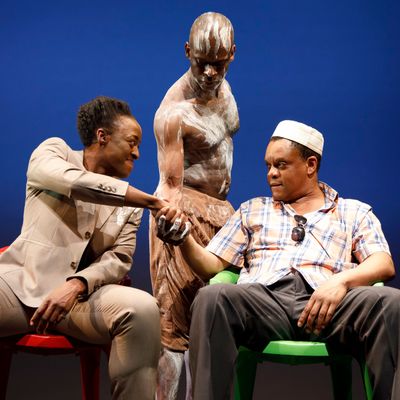
If you climb the stairs to the Public’s Martinson Theater instead of taking the elevator, you’ll learn a few upsetting facts along the way. Posted on the stairwell’s walls in big red decals are data about the illegal ivory trade, which continues to thrive despite growing international efforts to combat it. The most visceral of these statistics: One elephant is killed every 15 minutes.
Mlima’s Tale, the new play by Lynn Nottage that you’ll see at the top, is dedicated to excavating the gnarly human details behind the assault on one of the planet’s most endangered animals. While it’s not a revelatory theatrical experience, the show is tightly crafted and engagingly performed, and there’s something strangely refreshing about an issue play that’s not pretending to be something else. Inside the boundaries it’s set for itself, Mlima’s Tale knows what it’s about and moves us swiftly and often effectively through its story of man’s inhumanity to beast.
Nottage, who’s won Pulitzers for Ruined and Sweat, is both attracted to sociopolitical subject matter and fascinated by form. Ruined, which followed a group of women surviving the horrors of civil war in the Democratic Republic of the Congo, took its structural cues from Brecht’s Mother Courage and Her Children. Mlima’s Tale is a formal riff on La Ronde, a turn-of-the-century drama by the Austrian Arthur Schnitzler that provoked scandal with its frank depiction of a variety of class-crossing sexual encounters. La Ronde is made up of duets—A sleeps with B; B sleeps with C; C sleeps with D, and so on—and Nottage picks up on its undercurrents of bargaining and exchange, moving them to a more literal meat market to tell the mostly posthumous story of Mlima, an ill-fated elephant.
Apart from a prologue and an epilogue in which we hear from Mlima himself, the play is a series of two-person negotiations. It’s no spoiler to reveal that the titular elephant, one of the last “big tuskers” roaming the Kenyan savannah, is dead from almost the very beginning. Sahr Ngaujah, the intense, athletic actor portraying Mlima, walks through the play as a spirit, physically standing in for the massive tusks that are ripped from his body and shipped off down the “Ivory Highway.”
It’s a very neat structure — almost too neat, and if Nottage’s play lacks something, it’s a sense of surprise. Within ten minutes, we can tell how Mlima’s Tale is going to go. We’ll watch the poacher pass off the tusks to the corrupt police chief. We’ll see the corrupt police chief try to buy out his nephew, the game warden of the park where Mlima was supposed to be under protective observation. We’ll see the warden yield to pressure from the park’s director of wildlife to finger the wrong men for Mlima’s killing, thus avoiding the blame and closing the case. We’ll see the police chief’s slick business associate pass the tusks off to his fence. We’ll see the fence sneak them into an American ship captain’s Vietnam-bound cargo. We’ll see the captain get detained by Vietnamese customs officials, who happily take a bribe in exchange for clearing the captain of contraband charges and making the tusks disappear. And so on down the line.
With every exchange, someone’s integrity dies. With every encounter, greed and weakness and self-preservation win the day. Meanwhile, the ominous spirit of Mlima stalks through each scene. In a stark, dance-like ritual after his character’s death, Ngaujah covers his face and torso with streaks of white paint: During the subsequent scenes he touches each new corrupted character, smearing the paint down their arms or across their chests, marking them for their complicity as they go about their business.
It’s a nice visual effect, though it starts to lose its oomph in its predictability. I once worked with a director who compared the process of structuring a play—of doling out information to the audience—to the trail of crumbs Hansel and Gretel leave in the forest: “Too few crumbs,” he said, “and the audience will get confused. They’ll fall behind and stop listening. But too many crumbs and they’ll get ahead of you. They’ll stop listening not because they’re confused but because they’re bored.” Mlima’s Tale suffers from too many crumbs, from a dependence on inevitability over revelation. But what keeps it from falling into boredom is the sharp work of its director, Jo Bonney, and its hard-working ensemble of actors.
Apart from Ngaujah’s Mlima, only three performers stand in for the whole world of humanity, facilitating the journey of the fallen elephant’s coveted tusks. Kevin Mambo, Ito Aghayere, and Jojo Gonzalez are a deft, entertaining trio, jumping from character to character with dexterity and just enough of a sense of exaggeration, without slipping into caricature. With the help of Jennifer Moeller’s sensible costumes, they embody Somalian poachers, Kenyan officials, a Vietnamese black-market dealer, and a Chinese master sculptor and nouveau riche millionairess, among others. Aghayere (the cast’s one woman) is particularly effective as the oily, cocksure Hassan Abdulla, a Tanzanian businessman with a wolfish smile, a Miami Vice suit, and a hole where his conscience should be; and Gonzalez stands out as Thuy Fan, the black market trader, one of those deceptively casual figures of danger that pop up in gangster movies — a sweaty, obsequious little man in board shorts and flip-flops who probably wouldn’t think twice about knifing you.
Bonney does crisp, uptempo work with her actors, and scores the transitions between Nottage’s duets at a confident clip. Riccardo Hernandez’s set is mostly an empty box, a stark space in which Lap Chi Chu’s richly colored lights and a series of moving panels with projected scene titles can do the storytelling. But the spareness works, and Bonney doesn’t overburden the play with gestures. She seems to sense that, despite the ponderous nature of its subject matter and its central creature, it won’t really support heavy directorial flourishes. She needs to keep it moving, and she does.
Unfortunately for Ngaujah, his soliloquies are the hardest part of Nottage’s play to bring to life. The dialogue between the (mostly) corrupt human beings often crackles, but when Mlima is left alone onstage, he’s got to deliver somewhat purple monologues about listening to the earth and remembering his ancestors. Often more effective than his words is the accompanying sound design by Darron L. West and the live music and sound provided by Justin Hicks, which fill the space with the heavy echoes of animal breathing, insects whirring, and night on the savannah. For me, Mlima’s presence was most powerful in silence rather than speech, as in the moment in which Ngaujah climbs onto the shoulders of the responsibility-shirking director of wildlife (a nervous, craven Mambo) while he gives a speech to the press.
That image told me all I needed to know. Even as I balked at the tone of Mlima’s monologues, I understand why Nottage gave him a voice. Humans are self-centered animals, and it struck me that perhaps part of Mlima’s tragedy is that we require our fellow creatures to be humanized—to be given memories and relationships and souls that can all be communicated through language—before we deign to empathize with them. Meanwhile, the wealthy materialists at the end of the Ivory Highway continue to provide the demand for the poor, self-preserving suppliers at the beginning of it. And in the time it took me to see the play and write this, 15 elephants died.





